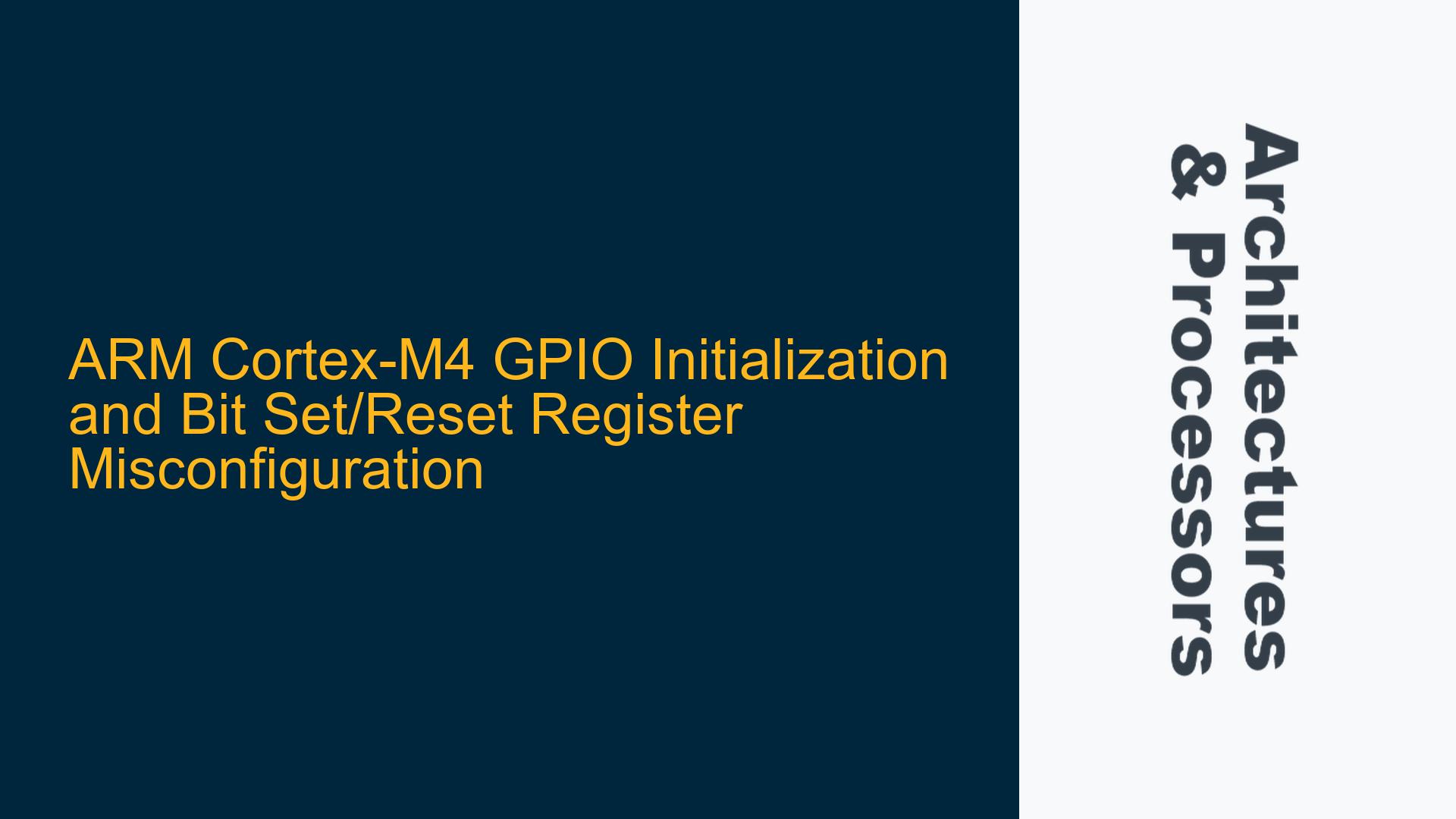GPIO Initialization and Clock Enablement in STM32F407xx
The core issue revolves around the proper initialization and configuration of General-Purpose Input/Output (GPIO) pins on the STM32F407xx microcontroller, specifically for controlling onboard LEDs connected to GPIO pins A6 and A7. The problem is twofold: first, ensuring that the GPIO peripheral clock is correctly enabled, and second, properly configuring the GPIO pins for output mode. Additionally, there is a critical misconfiguration in the usage of the Bit Set/Reset Registers (BSRR) for toggling the GPIO pins.
In the STM32F407xx microcontroller, GPIO pins are controlled through a series of registers that must be configured before the pins can be used for output. The key registers involved are the GPIO Mode Register (MODER), GPIO Output Type Register (OTYPER), GPIO Output Speed Register (OSPEEDR), and GPIO Pull-Up/Pull-Down Register (PUPDR). Each of these registers must be set correctly to ensure the GPIO pins operate as intended. Furthermore, the GPIO peripheral clock must be enabled through the Reset and Clock Control (RCC) module, specifically via the AHB1ENR register.
The issue is compounded by the incorrect usage of the Bit Set/Reset Registers (BSRR). The BSRR register is used to set or reset individual GPIO pins in a single atomic operation. However, the initial code incorrectly attempts to set and reset the pins using the same register (BSRRL), which leads to undefined behavior. The correct approach involves using both the BSRRL and BSRRH registers to set and reset the pins, respectively.
Misconfigured Bit Set/Reset Registers and Clock Enablement
The primary cause of the issue lies in the misconfiguration of the Bit Set/Reset Registers (BSRR) and the potential oversight in enabling the GPIO peripheral clock. The STM32F407xx microcontroller requires explicit enablement of the GPIO peripheral clock before any GPIO operations can be performed. This is done by setting the appropriate bit in the RCC_AHB1ENR register. In the provided code, the GPIO clock is correctly enabled, but the issue arises from the incorrect usage of the BSRR registers.
The BSRR register is divided into two parts: BSRRL (Bit Set Reset Register Low) and BSRRH (Bit Set Reset Register High). The BSRRL register is used to set the lower 16 bits of the GPIO port, while the BSRRH register is used to reset the lower 16 bits. The initial code incorrectly attempts to set and reset the pins using the BSRRL register, which is not the intended usage. The correct approach is to use BSRRL to set the pins and BSRRH to reset them.
Additionally, the GPIO pins must be configured for output mode by setting the appropriate bits in the GPIO_MODER register. The GPIO_MODER register controls the mode of each GPIO pin, with each pin having two bits that determine whether it is in input, output, alternate function, or analog mode. For output mode, the corresponding bits must be set to 01. The provided code correctly sets the GPIO_MODER register for pins A6 and A7, but the incorrect usage of the BSRR registers prevents the pins from toggling as expected.
Correcting GPIO Initialization and BSRR Usage
To resolve the issue, the following steps must be taken:
-
Ensure GPIO Clock Enablement: The GPIO peripheral clock must be enabled by setting the appropriate bit in the RCC_AHB1ENR register. This is done using the following line of code:
RCC->AHB1ENR |= RCC_AHB1ENR_GPIOAEN;This line ensures that the GPIOA peripheral clock is enabled, allowing the microcontroller to access and control the GPIOA registers.
-
Configure GPIO Pins for Output Mode: The GPIO pins must be configured for output mode by setting the appropriate bits in the GPIO_MODER register. For pins A6 and A7, the following code is used:
GPIOA->MODER |= GPIO_MODER_MODER6_0 | GPIO_MODER_MODER7_0;This sets the mode of pins A6 and A7 to output mode (01 in the MODER register).
-
Set GPIO Output Type and Speed: The GPIO output type and speed must also be configured. The output type is set to push-pull by clearing the corresponding bits in the GPIO_OTYPER register:
GPIOA->OTYPER &= ~(GPIO_OTYPER_OT_7 | GPIO_OTYPER_OT_6);The output speed is set to high speed by setting the appropriate bits in the GPIO_OSPEEDR register:
GPIOA->OSPEEDR |= GPIO_OSPEEDER_OSPEEDR7_1 | GPIO_OSPEEDER_OSPEEDR6_1; -
Correct Usage of BSRR Registers: The BSRR registers must be used correctly to set and reset the GPIO pins. The BSRRL register is used to set the pins, while the BSRRH register is used to reset them. The correct code for setting and resetting pins A6 and A7 is as follows:
GPIOA->BSRRL |= 0x00C0; // Set pins A6 and A7 GPIOA->BSRRH |= 0x00C0; // Reset pins A6 and A7This ensures that the pins are toggled correctly in the main loop.
-
Implement a Delay Function: A simple delay function is used to create a visible blink effect. The delay function is implemented as follows:
void myDelay(int times) { volatile int i, j; for (i = 0; i < times; ++i) { j++; } }This function creates a busy-wait delay by incrementing a volatile variable, which prevents the compiler from optimizing away the loop.
-
Main Loop for Blinking LEDs: The main loop continuously toggles the GPIO pins using the corrected BSRR register usage and the delay function:
int main(void) { ini(); // Initialize GPIO pins while(1) { GPIOA->BSRRL |= 0x00C0; // Set pins A6 and A7 myDelay(200000); // Delay GPIOA->BSRRH |= 0x00C0; // Reset pins A6 and A7 myDelay(200000); // Delay } return 0; }
By following these steps, the GPIO pins A6 and A7 will be correctly initialized and toggled, resulting in the desired blinking LED effect. The key takeaway is the importance of correctly configuring the GPIO registers and using the BSRR registers as intended. This ensures that the microcontroller can reliably control the GPIO pins and achieve the desired functionality.
Summary of Key Points
| Aspect | Description |
|---|---|
| GPIO Clock Enablement | Ensure the GPIO peripheral clock is enabled via RCC_AHB1ENR. |
| GPIO Mode Configuration | Set GPIO_MODER to configure pins A6 and A7 as output. |
| Output Type and Speed | Configure GPIO_OTYPER and GPIO_OSPEEDR for push-pull output and high speed. |
| BSRR Register Usage | Use BSRRL to set pins and BSRRH to reset pins. |
| Delay Function | Implement a busy-wait delay function for visible blinking. |
| Main Loop | Continuously toggle GPIO pins using the corrected BSRR register usage. |
This detailed guide should help in understanding and resolving similar issues related to GPIO initialization and configuration on the STM32F407xx microcontroller.






